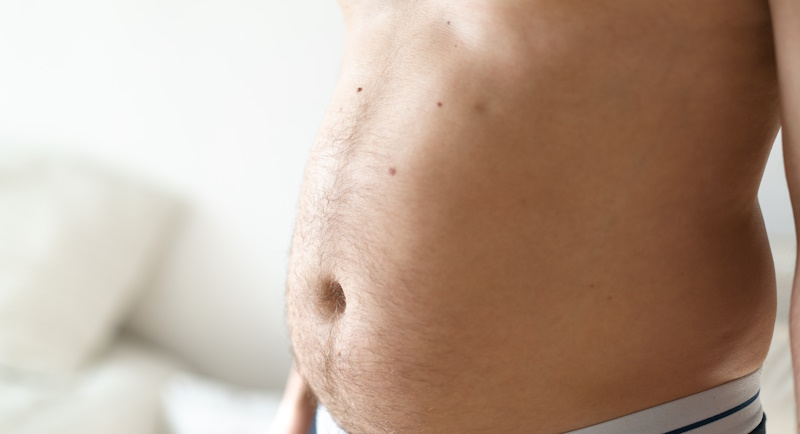Visceral Fat – Fighting the fat you cannot see
As men grow older, their bodies undergo various changes that make it challenging to maintain a healthy weight. Their metabolism slows down, testosterone levels decline, and they often consume an abundance of calories. Excess calories the body has no use for turn into fat if not burned off. These factors contribute to decreased calorie burning and increased body fat accumulation, which can have numerous negative health effects. To prevent these problems, men must make conscious efforts to stay active, maintain a healthy diet, and manage their weight throughout their lives.
Understanding visceral fat
Excess fat isn’t the only issue – its’ location matters too. Subcutaneous fat found just beneath the skin, doesn’t pose a significant health risk, unlike the fat, called visceral fat that accumulates around the waist.
Visceral fat, a dangerous type of adipose tissue, is stored within the abdominal cavity at waist level, encircling vital organs such as the pancreas, liver, and intestines. Excess body fat can lead to chronic health conditions like hypertension, type 2 diabetes, and heart disease. Monitoring one’s visceral fat levels to maintain good health is crucial.
Excessive accumulation of visceral fat, a type of intra-abdominal adipose tissue that constitutes only 10% of the total body fat, has been shown to increase the risk factors for heart disease. Research findings suggest that high visceral fat levels can significantly elevate blood pressure, blood glucose, and total cholesterol, key cardiovascular disease determinants. To prevent risk factors for heart disease, it is recommended that individuals with excess visceral fat undertake appropriate measures to reduce it.
How to measure visceral fat
The measurement of visceral fat can be easily monitored through the use of a tape measure. To accurately measure this, position the tape at the highest point of your right hipbone, and then wrap it around your waist at the level of your navel, taking care not to constrict or compress the area. A waist circumference that exceeds 40 inches is indicative of excess visceral fat in men. Additionally, one should be cognizant of any tightness in clothing, which may also serve as a sign of increased visceral fat.
Fighting visceral fat
The most effective approach to combating body fat, whether visible or concealed, is a comprehensive strategy involving aerobic exercise, strength training, and a balanced diet. It is important to bear in mind, however, that visceral fat, which is not externally visible, may prove more challenging to eliminate. Visceral fat is typically gained before subcutaneous fat; only about one-third of weight loss typically comes from visceral fat reduction.
It is generally recommended to incorporate a combination of moderate-to-intense aerobic exercise for 30 minutes to an hour, two to three days per week, along with two weight or resistance training sessions per week to enhance muscle mass. This combination has proven effective in burning calories and accessing stored visceral fat, making it a viable option for maintaining good health.
Selecting the optimal form of aerobic exercise and intensity of the chosen activity is vital for raising the heart rate to a level that hinders the ability to engage in a conversation. Additionally, it is highly recommended that high-intensity interval training (HIIT) be incorporated into one’s aerobic exercise regimen.
High-intensity interval training (HIIT) involves alternating between high-intensity aerobic exercise periods and rest or lower-intensity activity. This exercise regimen has been shown to result in many healthy benefits provide numerous health benefits, including improved cardiovascular fitness, increased endurance, and enhanced metabolism.
Individuals, especially if just starting a new exercise routine, should consider seeking the guidance of a certified personal trainer when designing a HIIT program to get the best results. A trainer can provide valuable expertise in developing a tailored program that considers an individual’s fitness level, goals, and any existing medical conditions.
Besides regular exercise, proper nutrition is critical for maximizing the benefits of HIIT. It’s essential to build and repair muscle tissue that relies on adequate daily protein intake. The recommended daily intake is 1.0 – 1.2 grams/protein per kilogram of body weight. It is important to note that body weight should be converted from pounds to kilograms by dividing by 2.2 to determine the appropriate protein intake level.
For example, if your weight is 180 pounds, that is equivalent to 82 kilograms. Multiplying 82 by 1.0 – 1.2 gives you an estimate of 82 – 98 grams of protein you must consume daily. Some excellent protein sources are lean beef, eggs, fish, poultry, beans, and Greek yogurt. Protein powder is another good source of protein easily added to smoothies, oatmeal, or a glass of milk.
Dr. David Samadi is the Director of Men’s Health and Urologic Oncology at St. Francis Hospital in Long Island. He’s a renowned and highly successful board certified Urologic Oncologist Expert and Robotic Surgeon in New York City, regarded as one of the leading prostate surgeons in the U.S., with a vast expertise in prostate cancer treatment and Robotic-Assisted Laparoscopic Prostatectomy. Dr. Samadi is a medical contributor to NewsMax TV and is also the author of The Ultimate MANual, Dr. Samadi’s Guide to Men’s Health and Wellness, available online both on Amazon and Barnes & Noble. Visit Dr. Samadi’s websites at robotic oncology and prostate cancer 911.

